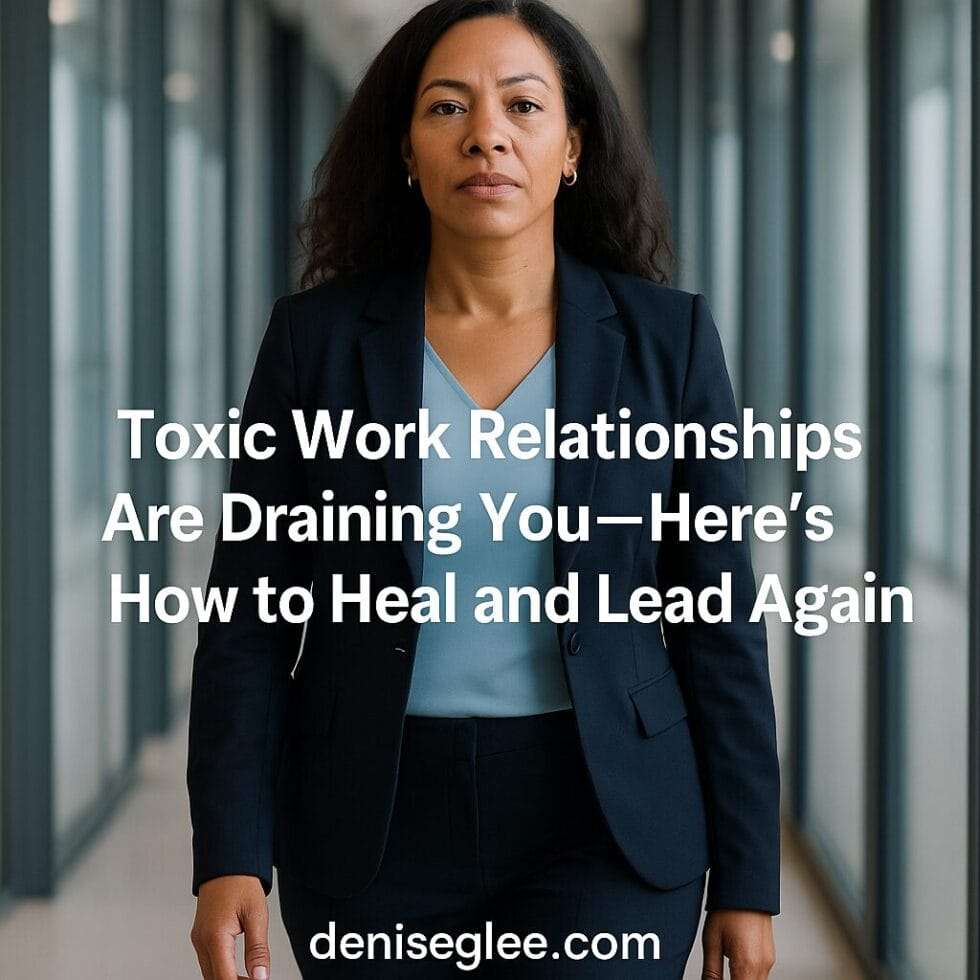
Toxic Work Relationships Are Draining You—Here’s How to Heal and Lead Again
- Updated: August 1, 2025
Toxic work relationships aren’t just uncomfortable—they’re corrosive.
And if you’re the one holding the line—founder, manager, consultant, or the person everyone leans on when the room gets quiet—you’ve probably told yourself, “This is just part of the job.”
But what if it’s not?
What if that passive-aggressive peer, micro-managing client, or tension-filled leadership team isn’t just a tough personality mix—but a toxic dynamic that’s quietly bleeding out your energy, confidence, and clarity?
Hi, I’m Denise G. Lee—Healing and Leadership Coach. I’ve walked this path. And in this post, I’m not just going to name what makes a work relationship toxic—I’m going to show you how to heal from it without burning your career to the ground.
If you’ve been shouldering dysfunction for the sake of professionalism…
If you’re leading through resentment, exhaustion, or quiet dread…
If you’ve been calling chaos “normal” because nobody else is naming it—this is for you.
We’ll break down the signs, unpack the brain science behind relational harm, and walk through real-world ways to reclaim your voice and presence—without losing your edge.
Let’s begin with the basics:
What actually makes a work relationship toxic?
Your Healing Roadmap Starts Here
⚠ What a Toxic Work Relationship Actually Looks Like (Even at the Top)
Let’s cut the fluff: toxic work relationships in leadership don’t always look like raised voices or HR violations.
Sometimes, it’s the strategic silence in meetings that leaves you out of key decisions.
The colleague who smiles in public—but undermines you in emails to the board.
The client who “loves your work” but ghosts on invoices and gaslights you when you push back.
The investor who praises your vision while slowly bleeding your authority with backchannel suggestions.

Toxicity at this level is politely dressed sabotage.
It hides behind metrics, euphemisms, and “just business” language.
And if you’ve been in this long enough, you know how it works:
You perform harder.
You double-check your tone.
You keep receipts—but still question your gut.
Because calling it what it is? That would make you “difficult.” “Emotional.” “Not strategic.”
And that’s the trap.
When power dynamics are involved, the dysfunction is harder to name—but more dangerous to endure. It erodes your decision-making, drains your energy, and makes you second-guess your leadership instincts. Not because you’re weak—but because you’re smart enough to survive in a system that rewards suppression.
This isn’t about petty disagreements.
It’s about emotional erosion in high-stakes spaces.
And it costs more than peace—it costs presence.
Let’s talk about how to spot it before it wrecks your clarity—or your career.
Have you ever tried to convince yourself that it wasn’t that bad?
— Denise G. Lee (@DeniseGLee) October 16, 2024
Yesterday, I was chatting with Tiffany, the podcast host of "True Crime Connections," and we discussed why some victims stay in harmful situations, even when it's obvious they need to leave.
In that moment, I…
I hope you know understand what a toxic work relationship looks like. In the next section, we will discuss signs that you are in a bad work environment.
🚩 7 Ways Dysfunction Hides in Your Leadership (and Drains You Quietly)
You don’t need a screaming match to know something’s off.
Toxicity in high-functioning spaces hides behind strategy decks, polite Slack threads, and high EQ vocabulary.
But your nervous system knows when something’s wrong.
Here’s what it might look like:

1. You’re Managing Feelings More Than Outcomes
You spend more energy de-escalating egos, softening your truth, or rewording feedback than actually solving problems. You’re not leading—you’re babysitting adults with titles.
2. Praise Is Political, Not Earned
Recognition only flows when you play the internal game. The loudest, most performative people get the spotlight—even when they’re actively wrecking team morale behind closed doors.
3. Passive Power Plays Are the Norm
People withhold information. You’re not looped in until after key decisions are made. You hear “we forgot to include you”—but you know better. You weren’t forgotten. You were managed.
4. You’ve Made Peace With the Dysfunction—But It’s Killing You Quietly
You’ve told yourself “every workplace has issues,” but your sleep sucks, your chest is tight before meetings, and your body flinches at calendar invites. That’s not normal. That’s depletion.
5. You’re the Emotional Dumping Ground for the Team
Everyone vents to you. They “just need five minutes.” And while you’re absorbing their stress, no one asks how you’re doing. You’re the container—but no one’s holding you.
6. Your Boundaries Keep Getting Tested (Then Blamed)
You say no. You push back. You ask for clarity. And suddenly you’re labeled “rigid,” “not collaborative,” or “intense.” But when you stay silent? You’re “disengaged.” Damned if you do…
7. You’re Becoming Someone You Don’t Recognize
You used to lead with fire and clarity. Now you second-guess your words. You rehearse basic asks. You brace for pushback before you’ve even spoken. This isn’t growth. This is erosion.
If even two of these hit close to home—it’s time to stop minimizing the damage.
You’re not “too sensitive.” You’re just finally awake to what your body’s been trying to tell you for years.
🧠 When Work Culture Becomes a Health Hazard
Let’s be clear—this isn’t just stress.
This is chronic nervous system activation that rewires how you think, lead, and relate.
When you’re in a toxic work environment (even as the leader), your body treats it like a threat zone. You may look composed on the outside—but inside? You’re in survival mode. And it shows up in very real, measurable ways.

🩺 The Science Is Blunt:
According to the American Psychological Association, 3 in 5 employees say work-related stress has negatively impacted their mental health—with burnout, anxiety, and emotional exhaustion topping the list.
The World Health Organization recognizes burnout as a workplace syndrome, noting symptoms like energy depletion, increased mental distance, and reduced efficacy—all of which mimic trauma symptoms in high-functioning people.
A 2022 study in Occupational Health Science found that toxic leadership environments significantly increase cortisol dysregulation, impairing sleep, immune response, and memory retention—especially in high-responsibility roles.
And yet… many leaders don’t name it. Why?
Because your coping looks like competence.
You’re still producing. Still responding. Still performing.
But inside, you’re crumbling.
This is the slow erosion I wrote about in Symptoms of Burnout: How to Improve Wellness at Work.
And if you’ve come from a high-pressure family system or trauma background, this isn’t just familiar—it’s scripted. You may be unconsciously replaying the same emotional patterns that felt like “normal” in childhood.
You can read more about that in:
👉 The Life Script Formula: Discovering Patterns That Shape Your Life
👉 The Hidden Link Between Childhood Trauma and Controlling Behavior
If you’re exhausted but can’t explain why…
If your team says you’re “fine” but your body says otherwise…
You might not be burnt out—you might be trapped in emotional hypervigilance.
And until you name it, you can’t change it.
🛠 How to Heal From Toxic Work Relationships (Without Losing Your Fire)
Healing doesn’t mean softening your edge or pretending it didn’t hurt.
It means pulling yourself out of survival mode—so you can lead without the internal flinch.
Here’s where to start:

✅ 1. Stop Calling It a “Bad Fit”—Name It.
The brain can’t heal from what it’s still trying to normalize. If you’re downplaying what happened (“It wasn’t that bad,” “We just had different communication styles”), you’re gaslighting yourself.
Call it what it was: emotional erosion, boundary violation, or covert sabotage.
That clarity isn’t drama—it’s your first act of recovery.
📏 2. Set Boundaries That Don’t Require Permission.
Toxic systems teach you to second-guess your limits. Healing means setting boundaries without waiting for others to approve, agree, or applaud.
Examples:
“I don’t take calls after 6 p.m. Period.”
“We’ll need to put that in writing before we move forward.”
“I’m not available to process that for you.”
Boundaries are not negotiations. They’re declarations.
🧠 3. Examine Your Own Triggers (So You Don’t Bring the Trauma Forward).
Not everything from your last job was “them.”
Healing also means asking:
“Why did I stay as long as I did?”
“What fear got activated when I tried to speak up?”
“Did this pattern start before that job?”
This is the work I unpack in The Life Script Formula. You’re not just breaking free from a role—you’re untangling a legacy.
🤝 4. Stop Healing in Isolation.
High performers love a solo fix. But emotional healing isn’t a DIY project. Whether it’s a coach, therapist, mastermind, or spiritual community—you need regulated mirrors, not just podcasts.
Connection heals what performance covered.
🚪 5. Know When to Leave—And When to Stay On Your Terms.
Sometimes healing means exiting.
Other times, it means staying—but with a new energetic contract.
If you do stay:
Shift from emotional sponge to strategic observer.
Detach from trying to “fix” others.
Focus on aligned output, not social belonging.
You’re allowed to protect your peace—even if it makes others uncomfortable.
🧘🏾 6. Build Recovery Rituals That Anchor You in Reality, Not Performance.
Create daily practices that remind your body: I am not in the line of fire anymore.
Try:
Cold showers or breathwork before hard meetings
A post-work decompression ritual (walk, music, stillness)
A grounding phrase like: “I don’t lead from fear—I lead from clarity.”
Even five minutes a day retrains your nervous system to stop bracing.
And here’s the truth: You’re not “too much” for noticing.
You’re just done calling dysfunction your job description.
🧭 How to Reclaim Your Leadership After the Fog Clears
When the dust settles, and you’ve stepped out of the toxic dynamic, there’s a strange silence.
You’re no longer on edge.
But you’re also not quite yourself.
You’re tired in a new way—and unsure how to lead without the tension that once drove you.
That’s normal.
High-functioning leaders who’ve endured relational harm often go through a quiet identity collapse.
Not because they’re weak—
But because their clarity was forged in fire.
And now, the fire’s gone.
Here’s how to begin again—without burning yourself out:

🔍 1. Redefine What Power Means to You Now
Before, power may have meant being the one with answers, control, or output.
Now? It might mean presence. Boundaries. Honesty.
Reclaiming your leadership means letting go of roles you wore to survive.
Try asking:
“What kind of leader am I when I’m not compensating for dysfunction?”
🧭 2. Lead With Grounded Conviction, Not Emotional Armor
You don’t need to be “nice” to be respected.
You don’t need to be cold to be clear.
Post-healing leadership lives in the middle:
You state truth without trembling.
You set standards without shame.
You let go without needing to be understood.
This isn’t about bravado—it’s about emotional sobriety.
🤲 3. Choose Peace Over Performance (Even When Nobody’s Watching)
The most radical thing you can do after surviving dysfunction?
Not rebuild your schedule.
Not relaunch a project.
But choose peace. Without a pitch. Without a story.
You don’t owe your growth to Instagram or your progress to your next investor deck.
This quiet recalibration is your leadership becoming real.
🪨 You’re Not Broken—You’re Just Done Carrying What Was Never Yours
If you’ve been leading through dysfunction, bracing for impact, or silently absorbing emotional labor just to keep the peace—you’re not weak. You’re human.
Toxic work dynamics don’t just hurt your productivity.
They shrink your clarity.
They confuse your instincts.
They teach you to doubt your voice in rooms you built from the ground up.
But here’s the truth:
You don’t have to keep proving your strength by enduring things that drain you.
Healing is not indulgent.
It’s leadership work.
And it starts when you decide to stop calling your pain “professionalism.”
If you’re in this moment—fog lifting, heart beating faster, unsure what comes next—you’re not alone.
💛 Work with me, Denise G. Lee – Together, we’ll untangle the deeper patterns that hold you back and build a leadership rhythm rooted in truth, not performance.
👉 Explore coaching here
🎙️ Want more real talk?
Listen to The Introverted Entrepreneur for unfiltered conversations on leadership, healing, and emotional sobriety in business and life.
💌 Need to say something out loud to someone who gets it?
I’d love to hear from you.
👉 Send me a message
And just in case no one’s reminded you lately:
You’re allowed to lead without self-erasing.
You’re allowed to heal without over-explaining.
You’re allowed to outgrow the rooms that taught you silence.
Let’s build something stronger—starting from truth.





